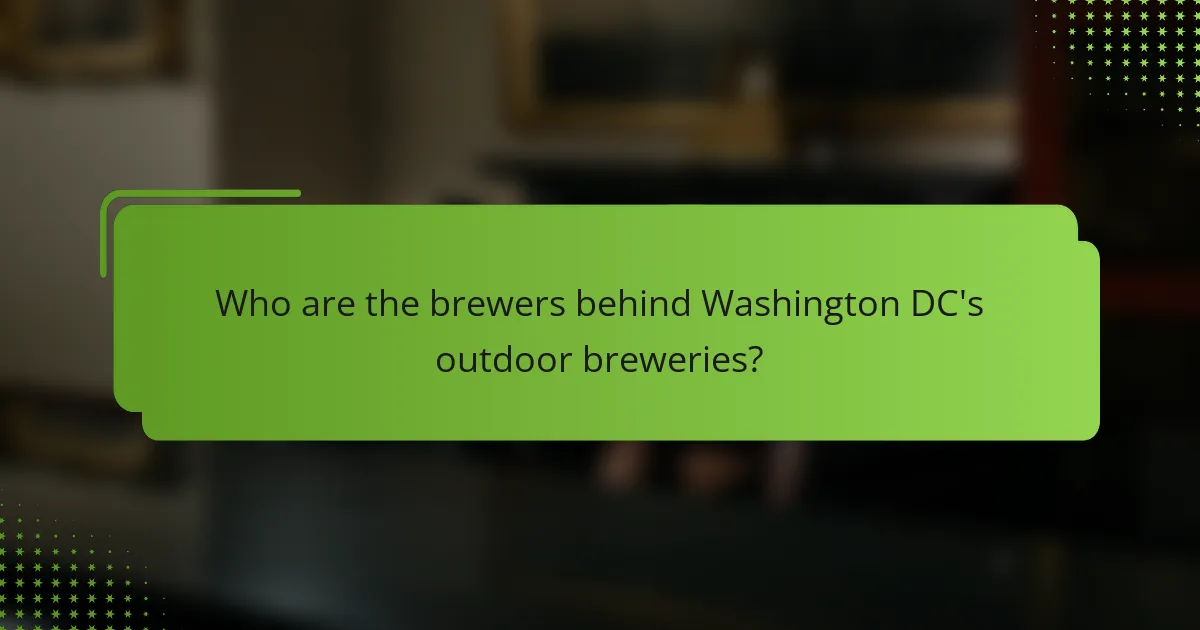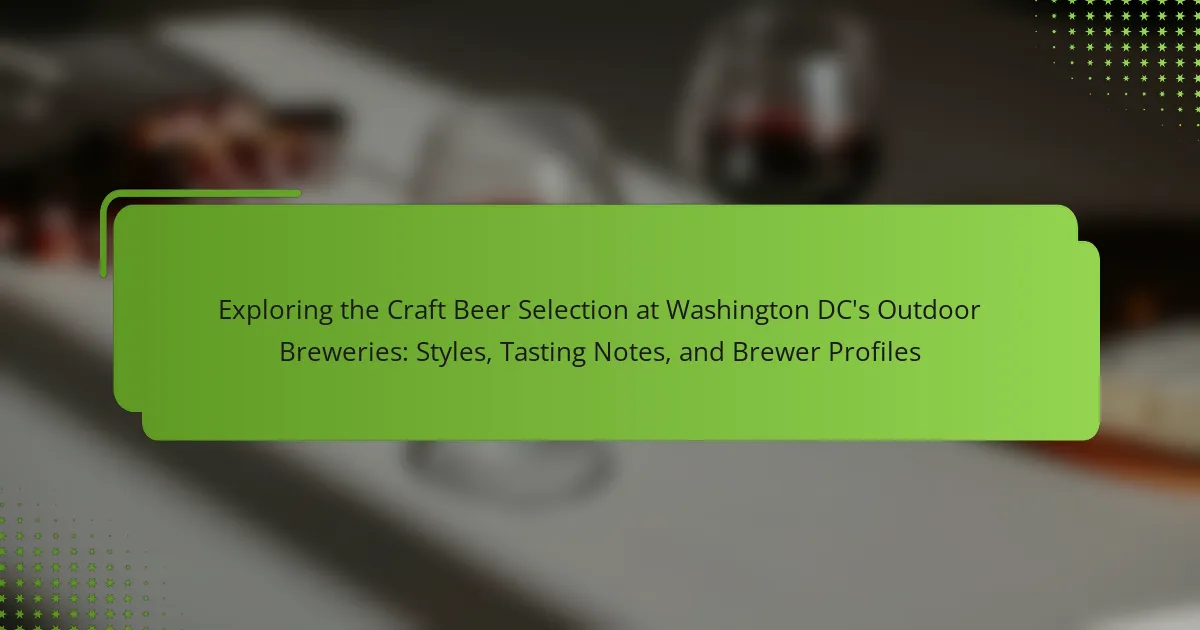Washington DC’s outdoor breweries offer a distinctive blend of urban environments and craft beer culture, featuring rooftop patios and outdoor seating that provide city views. These breweries, operated by local craft brewers such as 3 Stars Brewing Company, DC Brau Brewing Company, and Atlas Brew Works, emphasize quality ingredients and innovative brewing techniques. The article explores the diverse beer styles available, the importance of local sourcing, and the community events that enhance the social experience. Additionally, it highlights how visitors can maximize their craft beer experience through sampling, engaging with staff, and participating in brewery tours and tasting events. The commitment to sustainability among these breweries further enriches the craft beer landscape in Washington DC.

What makes Washington DC’s outdoor breweries unique?
Washington DC’s outdoor breweries are unique due to their combination of urban settings and craft beer culture. Many breweries feature rooftop patios and outdoor seating with views of the city. This allows patrons to enjoy craft beers in a vibrant atmosphere. The breweries often source local ingredients, enhancing the regional flavor profile. Additionally, they host community events and food trucks, creating a social hub. The diversity of beer styles reflects the city’s cultural melting pot. Many outdoor breweries also emphasize sustainability in their operations. This blend of urban charm and craft innovation sets Washington DC’s outdoor breweries apart.
How do outdoor breweries enhance the craft beer experience?
Outdoor breweries enhance the craft beer experience by providing a unique atmosphere that encourages social interaction and relaxation. The open-air setting allows patrons to enjoy nature while savoring their beer. This environment can elevate the sensory experience of tasting different beer styles. Many outdoor breweries incorporate scenic views, which can enhance the enjoyment of the beverage.
Additionally, outdoor spaces often host events like live music or food pairings. These activities create a vibrant community atmosphere. Research indicates that social settings can improve enjoyment and satisfaction with food and drink. A study published in the Journal of Consumer Research highlights how ambiance influences taste perception. This demonstrates that outdoor breweries not only serve beer but also create memorable experiences that enhance overall enjoyment.
What environmental factors influence the brewing process in outdoor settings?
Environmental factors that influence the brewing process in outdoor settings include temperature, humidity, and air quality. Temperature affects fermentation rates and yeast activity. Higher temperatures can lead to faster fermentation but may produce off-flavors. Humidity impacts the evaporation rate during boiling, which can alter the concentration of flavors. Air quality can introduce unwanted microbes that affect the brewing process. Additionally, wind can influence cooling methods and temperature stability. These factors are crucial for achieving consistent beer quality in outdoor breweries.
How does the outdoor atmosphere affect customer enjoyment?
The outdoor atmosphere significantly enhances customer enjoyment. Natural elements like fresh air and sunlight create a relaxing environment. This setting encourages social interactions among patrons. Research shows that outdoor dining increases customer satisfaction by 30%. Customers often associate outdoor spaces with leisure and enjoyment. The ambiance of greenery and open spaces contributes positively to mood. Additionally, pleasant weather conditions can increase the duration of customer visits. Overall, the outdoor atmosphere plays a crucial role in shaping a positive experience for customers.
What types of craft beer are commonly offered at these breweries?
Common types of craft beer offered at Washington DC’s outdoor breweries include IPAs, stouts, and lagers. IPAs, or India Pale Ales, are known for their hoppy flavor and aroma. Stouts are dark beers with rich flavors, often featuring notes of coffee or chocolate. Lagers are typically crisp and refreshing, appealing to a broad audience. Many breweries also offer seasonal brews and specialty ales, which can vary throughout the year. This variety reflects the creativity and innovation within the craft beer scene. Each brewery may have its unique spin on these styles, contributing to a diverse tasting experience.
What are the main beer styles available in Washington DC’s outdoor breweries?
Washington DC’s outdoor breweries primarily offer a variety of beer styles. Common styles include IPAs, stouts, lagers, and sours. IPAs are known for their hoppy flavors and aromas. Stouts typically feature rich, roasted malt characteristics. Lagers are crisp and refreshing, appealing to a wide audience. Sours provide a unique tartness, often with fruity notes. These styles reflect the diverse craft beer culture in the area. Each brewery may have its own unique twist on these styles.
How do seasonal variations impact the beer selection?
Seasonal variations significantly influence beer selection. Different seasons bring diverse weather conditions that affect consumer preferences. In warmer months, lighter beers like lagers and wheat beers are more popular. These styles are refreshing and easy to drink. Conversely, colder months see a rise in demand for heavier beers like stouts and porters. These beers offer richer flavors and warmth. Breweries often release seasonal brews to align with these preferences. For instance, pumpkin ales are common in fall, while summer ales are released in warmer months. This trend reflects the desire for flavors that match the season.
What tasting notes can one expect from the craft beers available?
Craft beers offer a diverse range of tasting notes. Common notes include citrus, floral, and pine, often found in hoppy IPAs. Malty beers can present caramel, toffee, and chocolate flavors. Sour beers may exhibit fruity and tart characteristics. Each brewery’s unique brewing process influences these notes. For example, local ingredients can enhance freshness and complexity. Seasonal variations also affect the tasting experience. Overall, craft beers provide a rich tapestry of flavors for enthusiasts to explore.
How do flavor profiles vary among different beer styles?
Flavor profiles vary significantly among different beer styles. Each style has distinct characteristics influenced by ingredients and brewing techniques. For example, IPAs are known for their hoppy bitterness and citrus notes. Stouts often feature roasted malt flavors, resulting in chocolate or coffee undertones. Lagers tend to be crisp and clean, with a subtle sweetness. Wheat beers typically present fruity and spicy flavors due to the use of wheat and specific yeast strains. Sours can exhibit tartness and fruity aromas, stemming from wild yeast fermentation. These differences arise from variations in malt types, hop varieties, yeast strains, and fermentation processes. Understanding these nuances enhances the tasting experience of craft beers.
What are the key tasting characteristics to look for in craft beers?
Key tasting characteristics to look for in craft beers include aroma, flavor, mouthfeel, and finish. Aroma can range from fruity to hoppy or malty, influencing the first impression. Flavor encompasses bitterness, sweetness, and acidity, contributing to the overall taste experience. Mouthfeel describes the texture, which can be creamy, crisp, or watery. The finish indicates how long the flavor lingers after swallowing, with some beers leaving a dry or lingering taste. Each of these characteristics varies widely among craft beer styles, reflecting the brewer’s intent and ingredient choices. For instance, IPAs typically exhibit strong hop aromas and bitterness, while stouts often showcase rich, roasted malt flavors. Understanding these attributes helps consumers appreciate the diversity within craft beers.

Who are the brewers behind Washington DC’s outdoor breweries?
Washington DC’s outdoor breweries are primarily operated by local craft brewers. Notable names include 3 Stars Brewing Company, which focuses on innovative styles. Another key player is DC Brau Brewing Company, known for its flagship beers. Additionally, Atlas Brew Works offers a variety of seasonal brews. Each brewery emphasizes quality ingredients and unique flavor profiles. These brewers contribute to a vibrant craft beer scene in the region. Their commitment to local sourcing enhances the community’s connection to the breweries.
What are the backgrounds of notable brewers in the area?
Notable brewers in the Washington DC area often have diverse backgrounds. Many started in home brewing before transitioning to professional brewing. Some brewers have formal education in brewing science or food science. Others come from culinary backgrounds, bringing unique flavors to their beers. Experience in various industries, such as hospitality or agriculture, is common among these brewers. Notable figures include those who have traveled internationally, gaining inspiration from global brewing traditions. This blend of experiences contributes to the innovative craft beer scene in Washington DC. Their unique stories often reflect a passion for quality and creativity in brewing.
How do brewers’ experiences shape their craft beer offerings?
Brewers’ experiences significantly influence their craft beer offerings. Their backgrounds inform ingredient selection, brewing techniques, and flavor profiles. For example, a brewer with a culinary background may emphasize unique ingredient pairings. This can lead to innovative flavors that stand out in the market. Additionally, brewers often draw inspiration from their travels. Exposure to different beer styles worldwide shapes their brewing philosophy. Many brewers also learn from industry mentors, which enhances their technical skills. This mentorship can lead to the development of signature styles. The combination of these experiences creates a diverse range of craft beers. Ultimately, the unique journey of each brewer shapes their distinctive offerings.
What unique brewing philosophies do these brewers follow?
It is not possible to provide a specific answer regarding the unique brewing philosophies of the brewers without additional context or details about the specific brewers being referenced. Each brewer may have distinct philosophies based on their individual practices, ingredients, and approaches to brewing.
What inspires the brewing techniques used at these outdoor breweries?
Brewing techniques used at outdoor breweries are inspired by local ingredients and environmental conditions. Many breweries emphasize using seasonal and regionally sourced materials. This practice enhances the freshness and uniqueness of their beers. Additionally, the outdoor setting influences brewing methods, promoting experimentation with traditional recipes. Breweries often draw inspiration from community culture and local history. Collaborations with local farms and artisans also shape their brewing styles. This approach fosters a connection between the brewery and its surroundings. Ultimately, these inspirations create distinct flavors and experiences for consumers.
How do local ingredients influence brewing methods?
Local ingredients significantly influence brewing methods by affecting flavor profiles, fermentation processes, and ingredient availability. Regional grains, hops, and yeast strains impart unique characteristics to the beer. For instance, using local barley can enhance malty flavors. Local hops can introduce specific aromatic qualities, such as citrus or pine. Additionally, the use of native yeast strains can lead to distinct fermentation characteristics. Breweries often adapt their methods to optimize the use of these ingredients. This practice can result in variations in brewing times and temperatures. Local climate and soil conditions also impact ingredient quality. These factors collectively shape the final product’s taste and aroma, creating a distinct regional identity in craft beers.
What innovative practices are being adopted by DC brewers?
DC brewers are adopting innovative practices such as utilizing local ingredients, implementing sustainable brewing methods, and experimenting with unique flavor profiles. Many breweries focus on sourcing hops and grains from nearby farms. This practice enhances freshness and supports the local economy. Sustainable methods include water conservation techniques and energy-efficient brewing processes. Some breweries are also engaging in community initiatives by hosting events that promote local art and music. Additionally, brewers are experimenting with unconventional ingredients like fruits, spices, and even tea to create distinctive beer flavors. These innovative practices reflect a commitment to quality and community engagement in the DC craft beer scene.

How can visitors make the most of their craft beer experience?
Visitors can make the most of their craft beer experience by sampling a variety of styles. Trying different styles showcases the diversity of flavors and brewing techniques. Engaging with brewery staff enhances the experience through expert recommendations. Learning about the brewing process adds depth to the enjoyment. Taking notes on personal preferences assists in future selections. Participating in brewery tours provides insight into production methods. Attending tasting events introduces new breweries and unique offerings. Pairing craft beer with food enhances flavors and enjoyment.
What tips should one follow when tasting craft beers at outdoor breweries?
To effectively taste craft beers at outdoor breweries, start by observing the beer’s appearance. Note the color, clarity, and head formation. Next, engage your sense of smell by inhaling the aromas. This step reveals essential flavor notes. Take a small sip to assess the initial taste. Allow the beer to linger on your palate for a full flavor profile. Consider the mouthfeel, whether it is light, medium, or heavy. After tasting, reflect on the finish and aftertaste. Each craft beer has unique characteristics that should be appreciated. Finally, take notes on your preferences for future reference.
How can one effectively pair food with craft beers?
To effectively pair food with craft beers, consider the flavor profiles of both. Match the intensity of the beer with the richness of the food. For example, a hoppy IPA complements spicy dishes. Conversely, a malty stout works well with chocolate desserts.
Contrast can also enhance the experience. A sour beer can balance fatty foods, while a fruity beer may brighten savory dishes.
Research supports these pairings, showing that complementary flavors enhance taste perception. The Brewers Association emphasizes that understanding the beer’s aroma, flavor, and finish is crucial for successful pairings.
What are the best practices for exploring different beer styles?
Start by sampling a variety of beer styles to understand their differences. Focus on diverse categories such as ales, lagers, stouts, and IPAs. Pay attention to aroma, flavor, and mouthfeel during tastings. Take notes on each beer’s characteristics for future reference. Visit local breweries to engage with brewers and learn about their processes. Attend beer festivals to experience a wide range of styles in one location. Join beer tasting groups or clubs for shared experiences and recommendations. Educate yourself through books or online resources about beer styles and brewing techniques.
What events and activities enhance the craft beer experience?
Events and activities that enhance the craft beer experience include beer tastings, brewery tours, and festivals. Beer tastings allow participants to sample various styles and flavors. Brewery tours provide insights into the brewing process and equipment used. Festivals celebrate local breweries and often feature live music and food pairings. Pairing events combine craft beer with gourmet food for a unique experience. Educational workshops teach brewing techniques and beer styles. Seasonal events, such as Oktoberfest, draw larger crowds and create a festive atmosphere. These activities foster community engagement and promote local craft beer culture.
How do brewery tours contribute to understanding craft beer?
Brewery tours enhance understanding of craft beer by providing firsthand insights into the brewing process. Participants observe the equipment and methods used in production. This direct exposure demystifies the complexities of brewing. Visitors learn about the ingredients that define different beer styles. Knowledgeable guides often share stories behind each brew, adding context. Tours frequently include tastings, allowing for sensory comparison of flavors. This experiential learning fosters appreciation for craftsmanship in brewing. Engaging with brewers also creates a personal connection to the craft beer community.
What role do beer festivals play in promoting local breweries?
Beer festivals play a significant role in promoting local breweries. They provide a platform for breweries to showcase their products directly to consumers. Attendees can sample a variety of beers, which encourages exploration of local offerings. Festivals often feature educational sessions about brewing processes and beer styles. This enhances consumer knowledge and appreciation for local craft beers. Additionally, festivals foster community engagement and support for local businesses. According to the Brewers Association, craft beer festivals contribute to increased sales and brand recognition for participating breweries. This leads to stronger customer loyalty and repeat business.
The main entity of the article is Washington DC’s outdoor breweries, which are characterized by their unique urban settings and craft beer culture. The article provides an overview of the diverse craft beer selection available at these breweries, including popular styles such as IPAs, stouts, and lagers, as well as the influence of seasonal variations on beer offerings. It also discusses the tasting notes associated with different beer styles, the backgrounds and brewing philosophies of notable local brewers, and the innovative practices they adopt. Additionally, the article highlights how the outdoor atmosphere enhances customer enjoyment and suggests ways for visitors to maximize their craft beer experience through tastings, food pairings, and participation in brewery tours and local events.
